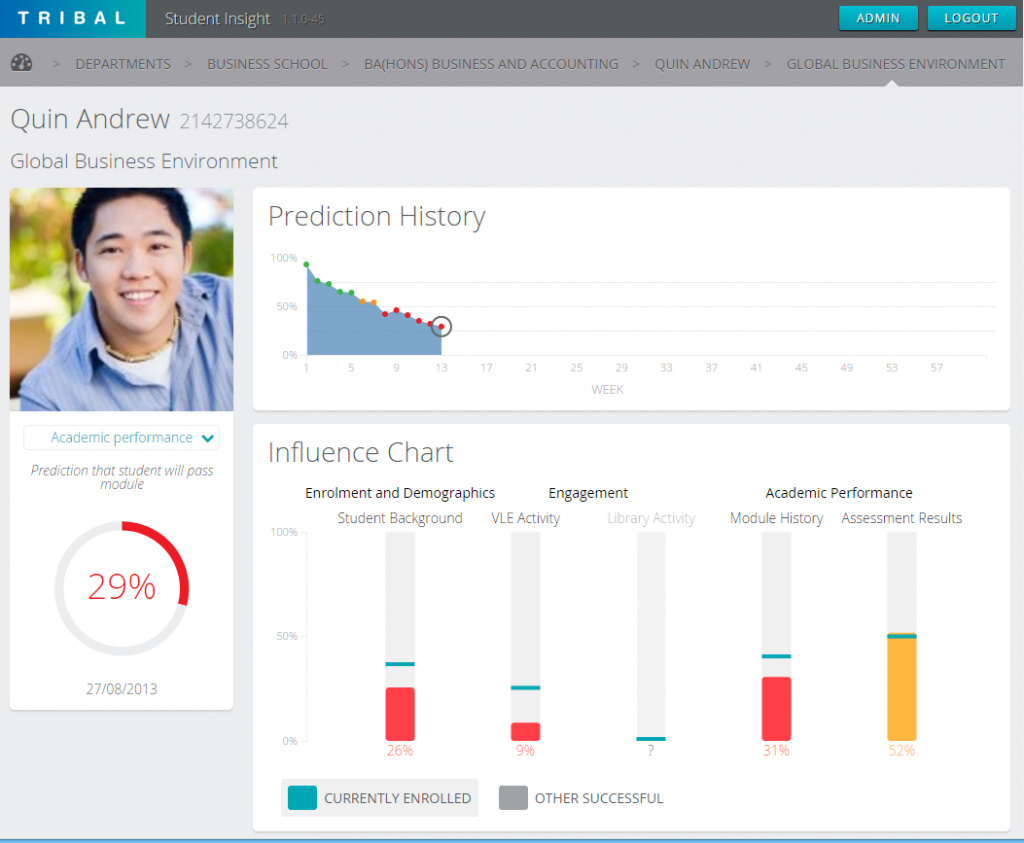 When I blogged about learning analytics systems being developed by vendors of student information systems (SISs) I mentioned Tribal’s emerging system, Student Insight, which it’s been developing with the University of Wolverhampton. Tribal’s SITS:Vision product is used by over half of UK higher education institutions. Meanwhile the company’s ebs4 SIS (or MIS as it’s known in further education) is in use by more than 120 colleges in England and Wales. There wasn’t much available on the web about the project so I contacted the company’s Data Scientist, Chris Ballard, to find out more.
When I blogged about learning analytics systems being developed by vendors of student information systems (SISs) I mentioned Tribal’s emerging system, Student Insight, which it’s been developing with the University of Wolverhampton. Tribal’s SITS:Vision product is used by over half of UK higher education institutions. Meanwhile the company’s ebs4 SIS (or MIS as it’s known in further education) is in use by more than 120 colleges in England and Wales. There wasn’t much available on the web about the project so I contacted the company’s Data Scientist, Chris Ballard, to find out more.
Niall: What’s the current state of the product?
Chris: Student Insight has emerged from R&D carried out with the University of Wolverhampton. We’re currently working with them and two or three other institutions to validate the capabilities of the product – and next year we plan to expand out the user base considerably. The system’s available now for early adopters.
Niall: How would you describe its functionality?
Chris: Student Insight enables customers to make the best use of the data they hold – not just in SITS but from external data sources, in particular the institution’s VLE or library. Firstly, it allows you to build a model or set of models to predict student risk. We’re focussing at the moment on retention and academic performance risk, in other words the risk of dropping out or failing a module.

We use the data in SITS to build this model and supplement it with data relating to engagement. It also shows historic data about the student and enables you to aggregate up risk predictions to module, course and faculty level too, as well as bringing in performance, engagement and retention data at each of these levels.
We feel it’s important that an institution is able to use student predictions and analytics of historic data side by side in order to make an informed decision about what should happen. Aggregating this data allows institutions to use the analytics to understand student risk and outcomes at course level, and well as for individual student support. This enables us to meet the needs for those institutions who want a “top down” approach to monitoring student cohorts, as well as a “bottom up” approach where it’s used to proactively identify specific students who may be at risk.
The predictive aspect of the system is customisable – we recognise that every institution has different datasets and differing requirements.
Niall: What technologies are you using? Is there an underlying business intelligence system for example?
Chris: It’s delivered as a software as a service cloud-based system – and also available for on-site installation. We use open source technology and data science libraries built by our team. The database is MongoDB, the widely-used NoSQL platform. It’s a document-oriented database which we use because it enables flexible modelling of different structures at an institution.
The predictive engine is built on top of well-established machine learning libraries implemented in Python. We use a machine learning ensemble technique to combine multiple predictive models to produce an overall prediction for individuals and groups. We’re not giving you a black box here but trying to make things transparent to the user. It shows whether there’s a high risk of underperformance and lets you drill down into that to get predictions on individual elements of performance.

Niall: Is it built just to work with SITS or can it integrate with other student information systems?
Chris: Actually it could work with any SIS. You can push data to it in a number of ways, by importing CSV files, using the system’s API or pulling in data by directly interrogating a database. When we were designing the system, a priority was for it to be open so that it could be used with all of Tribal’s education management systems, though our initial focus is on SITS customers.
We decided to provide an API because we recognised that institutions had different approaches and might want to deliver analytics at different levels. Many institutions are keen to start at a more aggregated level and to embed the analytics in existing portals. We’re working closely with early adopter partners because we want to make sure institutions can properly interpret the data they see – and we’re using the results to continuously refine the product.
Niall: What VLEs and other systems does it integrate with?
Chris: You can basically pull in any dataset. If you wanted to integrate Moodle or Blackboard you’d need to extract data from the user log files. This raw data is then loaded into Insight and processed to extract higher level predictive features. The next step is to have API integration with key VLEs so we can pull it in directly. Most institutions seem to be interested in using SIS data first and then to start integrating data from their VLE.
Niall: What about the metrics it produces? Can you tell me a bit more about them?
Chris: The two main areas as I mentioned earlier are around the prediction of retention and academic performance risk. Student Insight allows you to define datasets and map them to factors you determine such as information you know about the student when they enrol like their prior results. The system builds a machine learning ensemble against each dataset – you supply it with a set of historic training data and the outcome you know happened historically. In the case of academic performance that might be whether each student passed or failed the module, or achieved a certain grade. The models the system builds, learn the patterns in the underlying data, which are then used to predict the outcome you’ve trained it against.
At its heart it’s a very generic machine learning data modelling tool. We’re not enforcing any fixed models but we’re providing a framework that allows a set of predictive models to be built up and then delivered to different users using role-based security through dashboards built using HTML5. But we’re developing a standard set of models that can then be customised and automatically optimised for the institution using them.
Niall: Some of the learning analytics systems available are now building in workflow so that you can manage interventions and feed data on the effectiveness of those interventions back into the models. Does Student Insight do that at all?
Chris: Yes, managing interventions is a key part of the system. It allows you to flag cohorts of students or individuals at risk and then undertake an intervention. It integrates with another of our products called ESD (Enterprise Service Desk) which allows an institution to manage student support processes and also provides helpdesk capabilities. Intervention delivery can be managed and monitored by the student support team using ESD, based on the institution’s support workflow and policies. On our product roadmap is to consume what happens as a result of the intervention. We’ll look at the history of predicted outcomes for the student and then feed that back into the predictive model.
Niall: Well that’s helped to fill in the gap in my knowledge about Student Insight, which pretty much completes my review of the learning analytics systems available. Thanks very much, Chris – and please keep us posted about how the product is developing.

One reply on “Tribal Student Insight: an interview with Chris Ballard”
[…] Tribal Student Insight: an interview with Chris Ballard by Niall Sclater Interview with Chris Ballard, Data Scientist for Student Insight, a tool that allows customers to build models to predict student risk. the product is currently being developed by Tribal with the University of Wolverhampton. […]